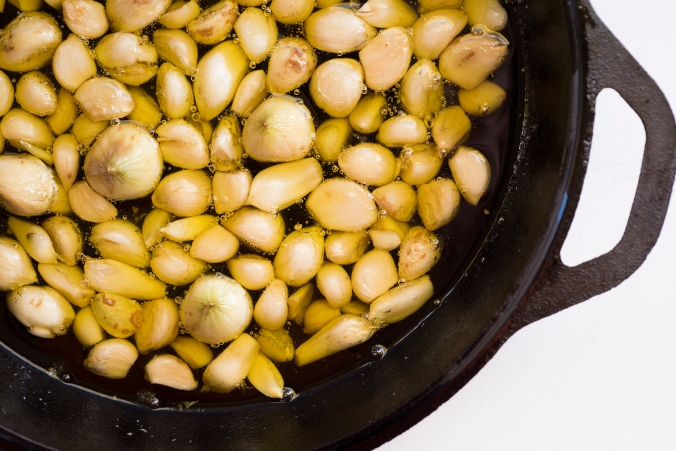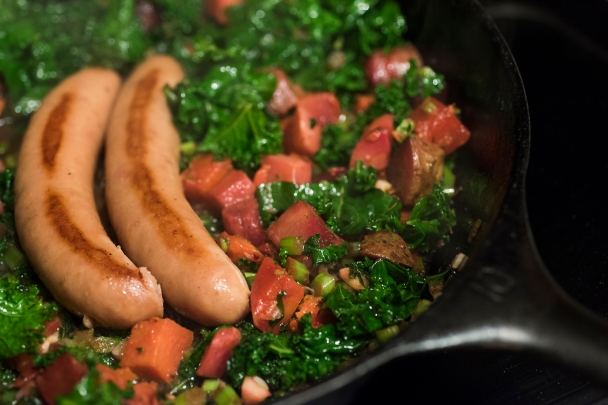In my holiday-themed classes, I talk about how I’d rather have two or three really stellar, delicious dishes at a meal than an extensive buffet of mediocrity. I feel the same way about cookware and knives: that is, I’d rather have a few sturdy, durable pieces that perform perfectly and can take a beating, rather than dozens of cheap, flimsy pans or knives that bend, warp, break or just plain fail. Cooking well isn’t only about starting with the best ingredients, but having the tools (and the skills) to turn those ingredients into something remarkable.

See how well-loved they are? I use mine every single day.
I love classic cast iron cookware. I love its heft, its lived-in appearance, its ability to retain heat. I love that it can be passed down through generations, and it only gets better. I love that it’s not shiny, not new, not a throwaway item. I love that it looks like something I should be using over a rickety camp stove to make a fry-up for hungry cowboys out on a cattle drive. I love that there is something of quality still manufactured in the United States. I love that cast iron asks you to cook well and simply and honestly.

You can roast peppers to smoky, tender perfection!
Cast iron cookware has been in use around the world for over two thousand years, and there’s a reason for that: nothing retains heat better while still holding its form. Before we became such a disposable society, cookware like this was valued for its durability and its effectiveness, especially when slow simmering tough cuts of meat. Cast iron goes from stove to oven, and it can be used to make anything: flavorful stews, crispy yet tender cornbread, smoky, filling beans. And nothing – I mean nothing – sears a steak like cast iron. Ask any cowboy.

You can create the most amazing garlic confit!
In the first half of the 20th century, cast iron cookware was ubiquitous in America. Then – coincidentally, right about the time we started turning to processed “convenience” foods – cast iron fell out of favor. It was too heavy. Too unwieldy. Impractical for TV dinners. Not suitable for microwaving soup. Couldn’t be put in the dishwasher. And so, most of the American companies went out of business. Today, Lodge is the only major manufacturer in the U.S., although a couple of smaller, “artisan” brands like Finex have appeared recently.

You can make one-pan meals!
I got rid of my grandmother’s cast iron pans at a garage sale years ago. Freshly minted from an uppity French culinary school, I thought cast iron was too down home, too low-class, too American for my lofty European cooking skills. What misplaced arrogance; to this day, I regret selling those pans. Thankfully, N found a ten-inch skillet for me at a church rummage sale, and I picked up my comal, a flat, round griddle traditionally used for making fresh tortillas, at a thrift store. My other two are classic Lodge, a Dutch oven and a grill pan. They’re all pieces I love cooking with.

You can put a little char on your tomatoes!
If you have any cast iron, take good care of it and it will take care of you for decades. Once it’s seasoned, meaning that you’ve basically created a nonstick surface through a combination of cooking fat and heat, never, ever use soap or any other chemical cleaner on it. Don’t immerse it in water, either. I typically just wipe my pans with a dry paper towel, if necessary, but if you’ve got stuck-on bits, you can heat the pan with a bit of water until they loosen, then scrape them out with a spatula. Really tough messes can be tackled with coarse kosher salt and a scouring pad. You can’t scratch them, can’t break them, don’t have to use any fancy utensils. They are indispensable workhorses.

And the most essential thing you can cook in your cast iron Dutch oven…
Cast iron’s greatest advantage, of course, is also its greatest downfall: their weight means they retain heat beautifully, so they get hot and stay hot, and they’re heavy. Treat them carefully and respectfully. Use both hands when lifting; never try to “one-hand” a cast iron pan. When you remove the pan from the oven and set it back on the stove or other protected surface, do as restaurant chefs do and make sure you leave your kitchen towels on the pan to remind everyone (including you) that it’s hot. Large pans that have been heating for a while may take a couple of hours to cool down, so have a safe place to put them where no one will burn themselves. Don’t leave water in the pan, either, as they can rust, though if you find an unloved, rusty specimen, you can always remove the rust with salt and reseason the pan.

…is quite simply the best bread you’ll ever taste.
Want to build your own cast iron collection? Start here, and thanks for buying American. Their stuff is top-notch and remarkably well-priced. Visit thrift stores and garage sales and flea markets (maybe you’ll find my grandmother’s pans?) but stay away from anything called an “antique store.” Little-known fact: antique is actually French for “overpriced stuff bought cheaply in a thrift store and aggressively marked up.” Cast iron’s resurgent popularity in recent years means anything even vaguely vintage can cost a fortune.

And while we’re on the topic of the French and expensive things, this stuff is cast iron too, but with an enamel coating. It’s gorgeous, comes in an array of coordinating colors so the kitchen at your Provencal château can match the Parisian pied-a-terre and it’s priced for really rich people. Tread carefully with these: they’re beautiful and colorful, but you can scratch that enamel without too much effort, and not all of the knobs and handles are designed for high heat. These definitely require a bit more attention, and a lot more money.
Go cook, friends. And save me some cornbread.
Love this post and love my cast iron too – I wouldn’t dream of making cornbread in any other type of pan, in fact, I think it’s actually illegal where I’m from 🙂 One question though, how does the “seasoning” of a pan or pot thru letting the grease, etc., get down into it and not using soap or cleaners to clean it – how does that not lead to unsanitary conditions for food / cooking?
LikeLike
Hi Kelly, thanks for your comment! The heat used in cooking keeps the pans hygienic. Fat also acts as a preservative (think of traditional duck confit preserved in fat), and since you’re constantly burning it off and adding more, it never has a chance to go rancid.
LikeLike
Oh interesting – thank you! You write such a wonderful blog and I so enjoy learning from your expensive knowledge about – seemingly – everything 🙂
LikeLike
Thank you! I really, really love food and cooking, and hopefully we inspire people to make tasty, healthy food at home.
LikeLike
Cast iron is LOVE!! I answered a CraigsList ad two days ago,10 inch cast iron pan, $5.00. What a steal, rusty, neglected, not anymore. I’m like you Elizabeth, I let my mom’s cast iron pans go at their estate sale, I didn’t have the money at the time to buy them, wish I had another chance. BTW, tonight, no knead bread with ham and bean soup.
LikeLiked by 1 person
Thanks, Jim! Glad to hear you’re rescuing cast iron pans! And dinner sounds delicious.
LikeLike
Love cast iron pans, Wagner Ware– a favorite! Right now enjoying an iron skillet #7, that seems to be just the right size for most dish preparations. Skip the high end, exceedingly heavy, expensive stuff. I’ve found some of my absolute favorites at yard sales and Goodwill. Really enjoyed this article, thank you—enjoy the season and best in the New Year!
LikeLike
Thanks so much, Nancy! Yard sales and Goodwill are definitely two of my favorite shopping destinations, too. Wishing you and yours all good things in the new year!
LikeLike